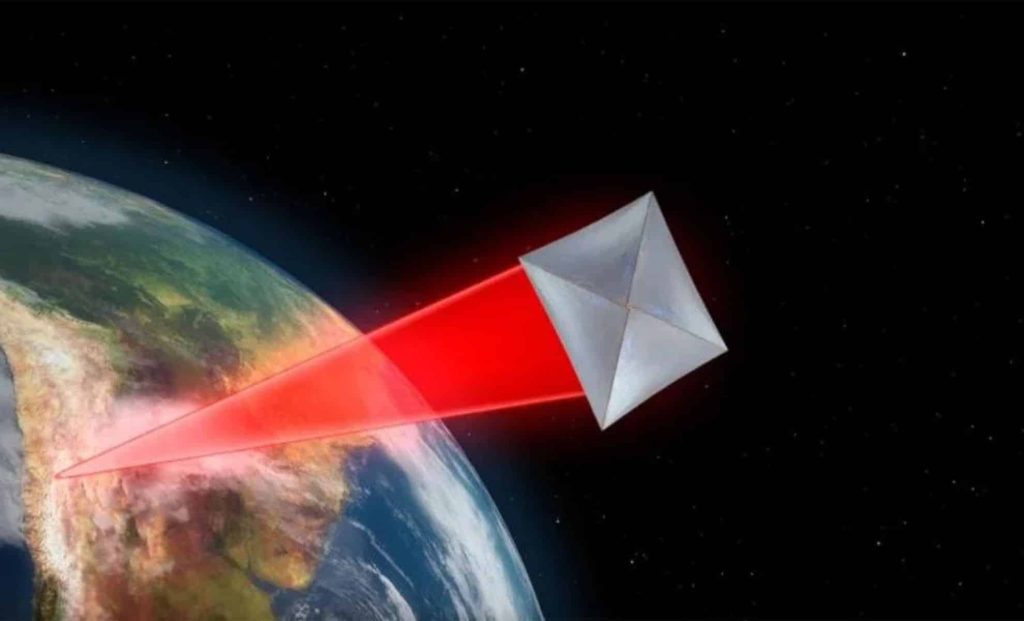Straight Out of a Sci-Fi Movie: Laser-Powered Spacecraft Could Travel Through Space in Record Time – The Daily Galaxy –Great Discoveries Channel

Scientists are developing a radical new way to propel spacecraft at unprecedented speeds—without using fuel. Known as laser-powered lightsails, this breakthrough technology could allow spacecraft to travel to distant star systems in a fraction of the time it would take with conventional rockets. Researchers at Caltech have successfully tested ultrathin sails that can be propelled by radiation pressure from lasers, bringing the concept closer to reality.For centuries, space travel has been limited by traditional propulsion methods, with chemical rockets remaining the primary means of launching spacecraft beyond Earth. While these rockets have enabled extraordinary achievements—from landing humans on the Moon to sending probes beyond the solar system—their reliance on fuel makes interstellar travel extremely slow and impractical. But what if there was a way to send spacecraft to other star systems at speeds never before imagined—without using conventional fuel?This once science-fiction concept is now becoming a reality thanks to groundbreaking research on laser-powered lightsails. Scientists at Caltech are working on ultrathin, laser-driven membranes that could potentially accelerate small spacecraft to a significant fraction of the speed of light. If successful, this technology could pave the way for the first interstellar missions within our lifetime, allowing us to explore planets orbiting distant stars far sooner than previously thought possible.Unlike traditional spacecraft, which rely on chemical propulsion or ion thrusters, lightsails use radiation pressure from lasers to generate thrust. By directing powerful laser beams at an ultrathin sail, scientists believe they can propel small, lightweight probes to incredibly high speeds. This method eliminates the need for heavy fuel loads, making it possible to reach distant destinations much faster than conventional rockets ever could.Leading this research is Caltech physicist Harry Atwater, who has been working on understanding how these ultrathin sails interact with light. According to Atwater, “The lightsail will travel faster than any previous spacecraft, with potential to eventually open interstellar distances to direct spacecraft exploration that are now only accessible by remote observation.”The concept is particularly exciting because it could enable missions to Alpha Centauri, our closest star system, in as little as 20 years—a journey that would take thousands of years using today’s fastest spacecraft. Such missions would allow scientists to directly observe exoplanets in other solar systems, search for extraterrestrial life, and study the nature of interstellar space in ways never before possible.While the potential of laser-powered lightsails is groundbreaking, making them practical and reliable presents several major challenges. The sails need to be extremely thin and lightweight, yet strong enough to withstand intense radiation pressure without tearing or deforming. They must also be able to ride a focused laser beam without tumbling or veering off course.“There are numerous challenges involved in developing a membrane that could ultimately be used as a lightsail,” says Atwater. “It needs to withstand heat, hold its shape under pressure, and ride stably along the axis of a laser beam.”One of the biggest obstacles is understanding how these materials behave under extreme conditions. Before scientists can build a full-scale lightsail, they need to conduct precise experiments to measure the forces at play. Atwater and his team have been working on a new experimental setup to do just that.“But before we can begin building such a sail, we need to understand how the materials respond to radiation pressure from lasers,” Atwater explains. “We wanted to know if we could determine the force being exerted on a membrane just by measuring its movements. It turns out we can.”To study the behavior of lightsails, Atwater and his team developed a miniature test platform in their lab. They created an ultrathin membrane made of silicon nitride, just 50 nanometers thick, and suspended it within a vacuum chamber. This miniature lightsail—described as a microscopic trampoline—was then exposed to a powerful argon laser, allowing scientists to measure how the sail moved in response to the radiation pressure.The key breakthrough was developing a precise method to measure the forces acting on the sail. The researchers built a highly sensitive interferometer, which allowed them to detect movements as small as a trillionth of a meter. By carefully calibrating their instruments, they were able to isolate the effects of radiation pressure from other disturbances, such as heat and environmental vibrations.“This is an important stepping stone toward observing optical forces and torques designed to let a freely accelerating lightsail ride the laser beam,” says Caltech researcher Ramon Gao, who played a key role in the project.The success of these initial experiments marks a major step forward in the development of lightsail technology. The next phase of research will involve:The ultimate goal is to build a fully functional 10-square-meter lightsail that can be propelled by a ground-based laser array. If successful, this could enable ultrafast missions to the outer solar system, with spacecraft reaching Jupiter in days instead of years and Pluto in just a few weeks.While there is still much work to be done, the progress being made in laser propulsion technology suggests that we may be on the verge of a new era in space exploration. The ability to send small, lightweight probes to distant stars could redefine how we explore the universe, opening up possibilities that were once thought impossible.With continued advancements in nanotechnology, laser optics, and space engineering, the dream of interstellar travel is moving closer to reality. It may not be long before humanity’s first spacecraft to another star system sets sail—not on rockets, but on beams of light.This article has been republished from the following materials. Note: material may have been edited for length and content. For further information, please contact the cited source.Got a reaction? Share your thoughts in the commentsEnjoyed this article? Subscribe to our free newsletter for engaging stories, exclusive content, and the latest news.Comment Save my name, email, and website in this browser for the next time I comment.
© 2024 | Daily Galaxy | All rights reserved
Source: https://dailygalaxy.com/2025/02/laser-spacecraft-travel-space-record-time/






